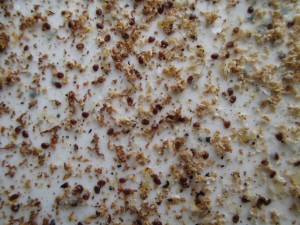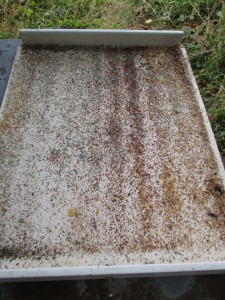Blog – bees, beekeeping & other sticky subjects
Alex flies with 2000 honeybees
7 November 2013 saw the inaugural flight of the Air Bee School and what a success it turned out to bee visiting schoolchildren in the remote and beautiful area surrounding Lake Vegoritida in northwest Greece.
Honeybees can cook!
Honeybees sting like a bee, bite like a snake, but did you know they can cook — hornets to death.
But we don’t think there are enough cooks to cope with the threat of the Asian Hornet!
Ready for take-off
Just 60 hours before take off for Alex’s first air bee-lesson for remote schools in Greece. Here’s a picture of how the airplane will look like on the 7th of November. There’s still time to take part.
The slide that caused a gasp
Here’s the slide that caused a sharp intake of breath and some reflex questions during Dr Max Watkins’ talk at the National Honey Show in Weybridge, Surrey, England last Friday.
Help educate the next generation
For just €5, you can get your name on a picture of a bee on the wing of Alex’s ultralight plane as it transports a flying beehive around schools to educate young people about the value of honeybees.
More Than Honey more than impressed
Last night near Vita’s HQ, BCOT kindly provided the venue for a pre-release screening of More Than Honey for local beekeepers.
School bees rescued
On a dark wet Friday afternoon after school, the cherry-picker arrived so that we could at last rescue the so-called swarm from the birch tree in the schoolyard.
Borage attack
The Vita Photo Competition 2013 closing date is looming — 20 October — and photos are still coming in. Here’s a very science fiction type shot …
A nasty end-of-season surprise from Varroa

Varroa mortuary -- dead varroa mites interspersed with various hive debris. (Click the image once for a closer look.)
After all the talk about this being a bad year for varroa in northern Europe, I received quite a shock last weekend when I inspected the varroa screens after the two-tray (four week) treatment regime of Apiguard.
As is common with Apiguard treatments, the first tray treatment produced only a small varroa drop. However, as the Apiguard took effect and as the emerging brood exposed more mites to the treatment, it must have been raining varroa!
I would guesstimate that the total mite drop was about 1000 — which is just at the danger threshold guideline set by FERA in the UK (in Europe and parts of the USA, the thresholds used is sometimes 3-4,000). I use one varroa monitoring screen in each of my apiaries and each apiary, 4 kms apart, showed similar results.
From this I take two lessons:
- Apiguard is working
- never be complacent about varroa mite levels — just because there is little evidence of their presence in a colony, they can be there in force ready to wreak havoc when circumstances conspire.
If those colonies had not been effectively treated this year, I dread to think what would have happened during the course of next year when the varroa levels would have started at a very high level. As it is, some varroa mites will always escape any treatment and live to breed in the next season. In my colonies I would expect that the starting number next year will be low.
(Incidentally, the knock-down from treatment with Apistan tends to show up much earlier, and large mite falls can be expected even in the first 24 hours — treatment should however be continued for the six-week period to make sure that the mites breeding in brood cells are killed.)
Turlough, Vita’s Guest Beekeeper Blogger
The view from Apimondia 2013
I’ve put a Facebook photo album up of some of the sights that have caught our eyes at Apimondia this year. The link below should be accessible even if you don’t have a Facebook account.
Below are a few tasters.
Enjoy!
Sebastian Owen, Commercial Development Manager
Follow me on Twitter: @SDWOwen






